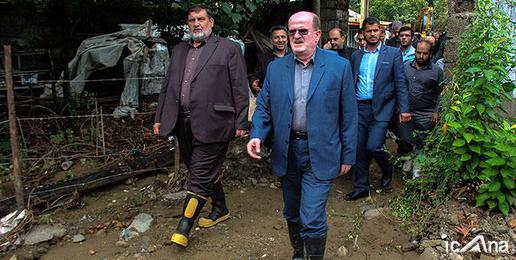President Hassan Rouhani has visited areas badly affected by the recent floods, including Mazandaran province and the badly damaged city of Aqqala in Golestan province, and has promised to help people rebuild their homes and restore the infrastructure.
Heavy rainfall continues across many Iranian provinces. Many people have no means of salvaging their properties and possessions, using their bare hands to try to clear some of the water out of their homes. Video footage of the floods, showing the plight of people across many provinces, including Golestan, Mazandaran, Fars, Khuzestan, Kermanshah, Lorestan, and North Khorasan, quickly made their way on to social media, and have now been viewed by millions. In some cities boats are the only means of transportation, including in the city of Gomishan on the eastern shore of the Caspian Sea in the northern province of Golestan.
On the night of Tuesday, March 25, a motorboat carrying volunteer relief workers and flood victims in the area of Gomishan hit a submerged bridge and overturned. Golestan officials initially reported that three people had died, three were missing and 18 people had been saved, but a few hours later the emergency services announced that they had found three more bodies.
President Hassan Rouhani inspected the damage caused by flash floods during his Wednesday night visit to Mazandaran and Golestan provinces, and he promised compensation to all those affected. “We will offer grants and long-term, low-interest loans to those who have suffered damages,” he told a gathering of people whose homes and orchards had been severely damaged. He expressed hope that the destroyed homes would be rebuilt before the end of the summer. “We will rebuild Golestan just as it was before, and we will stand by your side,” he told the local people.
It has been 10 days since heavy rains and floods first began and Rouhani, whose critics accused of mishandling the crisis, took several ministers with him to Golestan Province. The province’s governor was dismissed on Saturday, March 23 amid public outrage over his absence from work. The governor had been abroad when the disaster hit.
Rouhani’s hardline rivals have accused the government of doing too little, too late. The head of the judiciary, Ebrahim Raeesi, said on Tuesday, March 26 that officials who mishandled the disaster, causing the death of civilians, could face prosecution. The state meteorological organization has also faced criticism, including from Rouhani, for inaccurate weather forecasts and its late flood warnings.
The Iranian Legal Medicine Organization confirmed that so far at least 28 people have been killed by the floods. Of these,19 were killed by flash floods in the city of Shiraz, the capital of the southwestern province of Fars. Shocking photographs of the flood and its victims have been posted on social media, and city officials declared Thursday, March 28, a day of public mourning. At the same time, residents in some areas of the city are still struggling with the flood and its consequences.
Historical Sites Damaged and at Risk
There are reports of damages to some of Iran’s most ancient and cherished historical sites. A video [in Persian] posted on social networks shows a waterfall over Naqsh-e Rostam, 12 kilometers from Persepolis, where the mausoleums of four kings of the Achaemenid dynasty (550–330 BC) are located. “The cracks in Naqsh-e Rostam are unfortunately widening and the situation is critical,” said Mohammad Hossein Talebian, Vice President of Iran’s Cultural Heritage Organization (CHO). He also reported serious damage to the ancient bridge in Aqqala and to a large part of the Great Wall of Gorgan, a defensive line in northern Iran built during the Sassanid Empire (224–651 AD). “We will start the final evaluation when the water recedes,” he said, according to Tasnim News Agency.
According to Talebian, the historic bridges on the Zayanderud River in the province of Isfahan are also under threat. Talebian also broke the news about rising humidity in the Gonbad-E Kavous Tower in Golestan Province, and said that the CHO is monitoring the situation. The structure is one of the tallest brick towers in the world. Reports published prior to the floods said that it had incurred damage caused by heavy traffic in the area surrounding it.
Reports say that several bridges in Isfahan (built in the 15 and 16th centuries) and Shushtar (over two millennia old) have been damaged by the floods. In Lorestan province, the historic Falak ol-Aflak Fortress reportedly remains unharmed, but several bridges have been damaged — and some completely ruined.
Some parts of Tehran are said to be submerged in flood water. Tehran police reported that a seven-meter-long, five-meter-wide landslide hit the Kan-Souleqan Road near the capital. "Blocks of stone as heavy as four to five tons have hit the road," the Deputy Governor of Greater Tehran, Gholamhossein Aram, announced, adding, "No casualties have been reported so far." All restaurants and service stations in the basin of Darakeh, Darband, Lavasan and Fasham, north of Tehran, have been closed since Monday, March 25.
Twenty-four essential roads across the country have been closed until further notice due to snow, showers, fog, overflowing rivers, floods and the danger of avalanches. According to Iran’s Road Police, snow has been reported in parts of the provinces of East Azerbaijan, Mazandaran, Zanjan and Hamadan, while showers have been falling on the provinces of Tehran, Hamadan, Zanjan, Mazandaran, Hormozgan, Fars, Gilan, West Azerbaijan, Kermanshah, North Khorasan and Razavi Khorasan. Fog has been reported in areas of high elevations in Ardabil, Alborz, Zanjan, Qazvin and Semnan.
Ahmad Vazifeh, the Director General of the Meteorological Organization’s Forecasting and Warning department, said that two precipitation fronts will reach Iran by Saturday, March 30 and will cover the entire country, apart from the southwest, by Sunday.
visit the accountability section
In this section of Iran Wire, you can contact the officials and launch your campaign for various problems

























comments